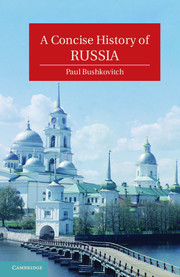Book contents
- Frontmatter
- Contents
- List of Figures
- Abbreviations
- Acknowledgments
- Prologue
- 1 Russia before Russia
- 2 Moscow, Novgorod, Lithuania, and the Mongols
- 3 The Emergence of Russia
- 4 Consolidation and Revolt
- 5 Peter the Great
- 6 Two Empresses
- 7 Catherine the Great
- 8 Russia in the Age of Revolution
- 9 The Pinnacle of Autocracy
- 10 Culture and Autocracy
- 11 The Era of the Great Reforms
- 12 From Serfdom to Nascent Capitalism
- 13 The Golden Age of Russian Culture
- 14 Russia as an Empire
- 15 Autocracy in Decline
- 16 War and Revolution
- 17 Compromise and Preparation
- 18 Revolutions in Russian Culture
- 19 Building Utopia
- 20 War
- 21 Growth, Consolidation, and Stagnation
- 22 Soviet Culture
- 23 The Cold War
- Epilogue
- Further Reading
- Index
5 - Peter the Great
Published online by Cambridge University Press: 05 June 2012
- Frontmatter
- Contents
- List of Figures
- Abbreviations
- Acknowledgments
- Prologue
- 1 Russia before Russia
- 2 Moscow, Novgorod, Lithuania, and the Mongols
- 3 The Emergence of Russia
- 4 Consolidation and Revolt
- 5 Peter the Great
- 6 Two Empresses
- 7 Catherine the Great
- 8 Russia in the Age of Revolution
- 9 The Pinnacle of Autocracy
- 10 Culture and Autocracy
- 11 The Era of the Great Reforms
- 12 From Serfdom to Nascent Capitalism
- 13 The Golden Age of Russian Culture
- 14 Russia as an Empire
- 15 Autocracy in Decline
- 16 War and Revolution
- 17 Compromise and Preparation
- 18 Revolutions in Russian Culture
- 19 Building Utopia
- 20 War
- 21 Growth, Consolidation, and Stagnation
- 22 Soviet Culture
- 23 The Cold War
- Epilogue
- Further Reading
- Index
Summary
The reign of Peter the Great saw the greatest transformation in Russia until the revolution of 1917. Unlike the Soviet revolution, Peter's transformation of Russia had little impact on the social order, for serfdom remained and the nobility remained their masters. What Peter changed was the structure and form of the state, turning the traditional Russian tsardom into a variant of European monarchy. At the same time he profoundly transformed Russian culture, a contribution that along with his new capital of St. Petersburg has lasted to the present day.
The first few years of Peter's rule gave little indication that such great events were coming. The removal of Sofia in 1689 gave control to Peter's mother and her Naryshkin relatives and their allies, who seem to have gotten along poorly with one another once in power. A son Aleksei was born in 1692 to Peter's wife Evdokiia, so the succession seemed assured. Peter himself remained in the background training his soldiers, drinking with the foreign officers in the German suburbs, and sailing his boats. Peter had many eccentricities, and they appeared early. He was nearly seven feet tall, but was thin-boned with narrow shoulders and rather fine features. He shaved his beard early but left a thin moustache. His capacity for alcohol was gigantic and this perhaps had some relationship to the endless “colics” and other stomach disorders that plagued him all his life. He sometimes flew into tremendous hysterical rages that only his wife (his second, Catherine) was able to calm. His relations with women were surprisingly restrained. His greatest recreation was anything that involved boats, leading him to go north to Archangel in 1693 to see the ocean for the first time. His mother Natalia sent him a letter ordering him not to go out to the dangerous open sea and he obeyed. Then in February 1694, she died. Right away Peter ceased to appear at any of the Kremlin ceremonies, and the whole ritual of the Russian court, now over two centuries old, came to an end. Then Peter went to Archangel again, and this time he went out to sea on a Dutch ship.
- Type
- Chapter
- Information
- A Concise History of Russia , pp. 79 - 100Publisher: Cambridge University PressPrint publication year: 2011

